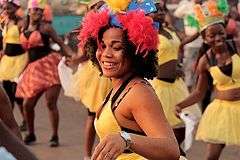Agila Social and Economic Carnival
| Agila Social & Economic Carnival | |
|---|---|
 | |
| Type | Social, Economic & cultural |
| Celebrations | Parades, parties, open-air performances |
| Begins | December 23–25 |
| Frequency | annual |
Agila Carnival is a social and economic event in Agila Town set up to showcase Idoma cultural renaissance.[1] According to the organizers of the Agila Carnival, it is aimed at reviving the interest of its cultural & economic values in a fast globalizing world of science and technology among the youth of the Idoma nation and its descendents. As a result of the thousands of people the carnival attracts from all walks of life, it serves as a boost to the economy of the Idoma land and that of the country at large.[2]
Benué is a state in the mid-belt region of Nigeria with a population of over 4,253,641 according to the 2006 census. Idoma and Tiv are spoken predominantly. There are other ethnic groups, including Igede, Etulo and Abakwa, Jukun, Hausa, Akweya and Nyifon.[3] Differences in cultural and social heritage tends to make them disagree in many things.[4]
The carnival since its emergence has played a large role in the unity of the people from this area, and as a result, fostering the unity and tranquility of the people of Benué State.[5]
History
In 2013,[6] Prince Edwin Ochai created the Agila Social & Economic Carnival,[7] with the aim of showcasing to the world the rich social, cultural and Economic endowment of the Idoma Nation through art, craft and social exhibitions.[8]
The Carnival events
The parades and other events happen during the three official days of carnival.[9] The carnival kicks off on 23rd morning and stretches to the afternoon of the same day with procession/Parade in otukpo[10] followed by migration from otukpo to Apa between the afternoon and evening of the first day. Later in the evening of the same day is another segment known as burn fire and performances by music artists.[11]
The carnival continues on 24 December with carnival displays in the morning followed by Masquerade display, and distribution of gifts to widows. Later in the evening in the same day is the performance by HERO's ambassadors (music & comedy).
The morning of 25 December which is the last day of the carnival is the migration of people from Apa to Otukpo. Proceed by the Face of Idoma beauty pageant.[12]
References
- ↑ "Archived copy". Archived from the original on 2015-06-17. Retrieved 2015-06-15.
- ↑ https://benuenewsonline.wordpress.com/2014/04/23/prince-edwin-ochai-why-i-started-the-agila-carnival-culture/
- ↑ Benué State
- ↑ "Archived copy". Archived from the original on 2015-06-17. Retrieved 2015-06-17.
- ↑ http://www.news.benuestate.net/news/benue-its-fight-to-finish-for-tividoma
- ↑ http://dapalszone.blogspot.com/2014/01/check-out-idoma-carnival-tagged-agila.html
- ↑ https://benuenewsonline.wordpress.com/2014/04/23/prince-edwin-ochai-why-i-started-the-agila-carnival-culture/
- ↑ http://naijatainmentxtra.blogspot.com/2014/01/agila-carnival-2013-in-pictures.html
- ↑ http://visionafricamagazine.com/magazine/index.php/current-edition/251-the-agila-social-a-economic-carnival-2013
- ↑ "Archived copy". Archived from the original on 2015-12-30. Retrieved 2015-06-15.
- ↑ http://benuepage.net/2014-agila-carnival-carnival-team-meets-stakeholders/
- ↑ "Archived copy". Archived from the original on 2015-06-17. Retrieved 2015-06-15.